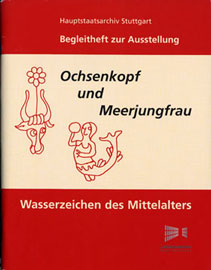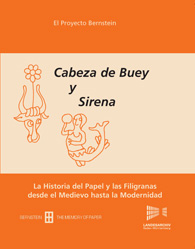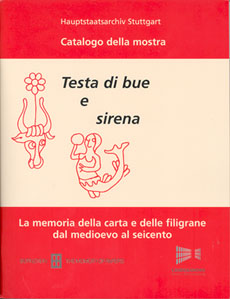r61 - 19 Jul 2013 - 08:59:33 GMT - EmanuelWengerYou are here: Bernstein > Main Web > ProjectExhibitions
Bull's head and mermaid. The History of Paper and Watermarks from the Middle Ages to the Modern Period.
An European travelling exhibition
Content
 This exhibition is dedicated to a special treasure within the framework of paper history research: watermarks. Visible when holding any bank note against light, watermarks were produced in a myriad of shapes from the 13th century on when they were first invented in Europe. They make an excellent mean to date unidentified documents, a Mozart manuscript for example, or authenticate works of art, such an etching signed "Rembrandt".
The public is presented with a concise and profound introduction to watermarks, techniques of paper manufacture and the scientific study of papers in general. A special section deals with the watermarks analyzed against the background of medieval symbolism. The importance of watermarks for paleography is also underlined. Watermark scholars and watermark collections in Europe receive a due share of focus, while the digital presentation of watermarks of several European databases establishes the connection between past and present.
A catalog with detailed scientific information serves to deepen the various aspects shown through the exhibition.
Outreach - The exhibition's goal is to promote interest and knowledge in the value of paper for the European cultural heritage. The organizers offer to loan the exhibition to institutions having an affinity with the subject. Costs are minimal (restricted to transportation) and setting up quick and space efficient (panels and showcases).
Keywords - Medieval History, Papermaking, Art History, Cultural Heritage, Digital resources for Humanities.
This exhibition is dedicated to a special treasure within the framework of paper history research: watermarks. Visible when holding any bank note against light, watermarks were produced in a myriad of shapes from the 13th century on when they were first invented in Europe. They make an excellent mean to date unidentified documents, a Mozart manuscript for example, or authenticate works of art, such an etching signed "Rembrandt".
The public is presented with a concise and profound introduction to watermarks, techniques of paper manufacture and the scientific study of papers in general. A special section deals with the watermarks analyzed against the background of medieval symbolism. The importance of watermarks for paleography is also underlined. Watermark scholars and watermark collections in Europe receive a due share of focus, while the digital presentation of watermarks of several European databases establishes the connection between past and present.
A catalog with detailed scientific information serves to deepen the various aspects shown through the exhibition.
Outreach - The exhibition's goal is to promote interest and knowledge in the value of paper for the European cultural heritage. The organizers offer to loan the exhibition to institutions having an affinity with the subject. Costs are minimal (restricted to transportation) and setting up quick and space efficient (panels and showcases).
Keywords - Medieval History, Papermaking, Art History, Cultural Heritage, Digital resources for Humanities.
Schedule
2013, 15 May - 8 October — Rollettmuseum-Stadtarchiv Baden. 2012, 27 July - 18 August — The European Research Centre for Book and Paper Conservation-Restoration Horn, Austria.(Photos) Wienerstrasse 2, 3580 Horn, Austria, T +43(0) 650 58 71 877 | +43(0) 2982 200 30 31 2012, 15 June - 1 July — Biblioteca Civica di Varallo, Varallo, Piedmont, Italy. (photos) (press releases)
Via Pio Franzani 2 - 13019 Varallo (VC), T +39 (0)163.51424 2011, 6 May - 2011, 10 July — Museo del tesoro del duomo, Vercelli, Italy
"Filigrane in edizioni vercellesi del XVI secolo", see Photos, La Stampa1 and La Stampa2
Piazza D'Angennes 5, I-13100 Vercelli 2009, 6 December - 2010, 31 January — Stiftung Zanders , Bergisch Gladbach, Germany
"Ochsenkopf und Meerjungfrau. Wasserzeichen des Mittelalters" (Photos)
Hauptstrasse 267, 51465 Bergisch Gladbach, T +49 (0) 2202 15 20 60 2009, 30 April - 27 June — Biblioteca Nazionale di Torino , Torino, Italy
"Testa di bue e sirena. Cartiere e filigrane piemontesi: prospettive di ricerca"
Piazza Carlo Alberto, 3, I-10123 Torino, T +39 (0)118101111 2008, 28 October - 31 December — Castello Sforzesco, Sala del Tesoro della Trivulziana, Milano, Italy
"Una firma nell’acqua - La memoria della carta e delle filigrane dal Medioevo all’età moderna"
Piazza Castello, I-20121 Milano, T +39 (0)2 8846 3700 2007, 8 September - 10 October — Istituto centrale di patologia del libro, Rome, Italy
"Testa di bue e sirena. Filigrane del medioevo" (Photos)
Via Milano, 76, I-00184 Roma, T +39 (0) 648 2911 2007, 9 July - 24 August — Paper and Watermark Museum, Fabriano, Italy
"Testa di bue e sirena - La memoria della carta attraverso le filigrane"
Largo Fratelli Spacca, I-60044 Fabriano, T +39 (0)732 709 297 2007, 22 March - 9 June — Museum im Schottenstift, Vienna, Austria
"Ochsenkopf und Meerjungfrau. Wasserzeichen des Mittelalters"
Freyung 6, A-1010 Wien, T +43 (0)1 534 98 2006, 14 December - 2007, 2 February — Archives of the State of Baden-Württemberg, Stuttgart, Germany
Ochsenkopf und Meerjungfrau. Wasserzeichen des Mittelalters
Eugenstraße 7, D-70182 Stuttgart, T +49 (0) 711 212 4272
Exhibition location map
View Larger Map
Catalogues
- Spanish catalogue: Cabeza de Buey y Sirena. La Historia del Papel y las Filigranas desde el Medievo hasta la Modernidad. (2011, 165p).
- Special Italian catalogue of the exhibition in Torino: Cartiere e filigrane piemontesi: prospettive di ricerca (2009, 38p).
- English catalogue: Bull's Head and Mermaid: The History of Paper and Watermarks from the Middle Ages to the Modern Period (2009, 128p).
- Second German catalogue: Ochsenkopf und Meerjungfrau: Papiergeschichte und Wasserzeichen vom Mittelalter bis zur Neuzeit (2009, 128p).
- Italian catalogue: Testa di bue e sirena: La memoria della carat e delle filigrane dal medioevo al seicento (2007, 96p).
- First German catalogue: Ochsenkopf und Meerjungfrau: Wasserzeichen des Mittelalters (2006, 72p).

Content of the Spanish catalogue (2011)
Prólogos- Filigranas de la Edad Media
Introducción
Bartolo de Sassoferrato - La historia y producción del papel desde el Medievo hasta la modernidad
Historia y fabricación del papel en el contexto histórico
El papel: desde Fabriano hacia Europa
Breve historia de la fabricación del papel en España y sus filigranas
Orígenes del papel en España
Gran demanda del papel: La introducción de la imprenta en España
El papel en el nuevo mundo
Decadencia de la fabricación del papel en España
El papel protagonista de la cultura en el periodo de la ilustración
El papel árabe e hispano árabe
El papel valenciano: su historia y sus filigranas
El esplendoroso pasado medieval
Monjes y libreros, fabricantes de papel
El “Siglo de las Luces”: crecimiento y expansión
La tardía y difícil mecanización
Capitalización y concentración empresarial
La corona Española proveedora del papel en Hispanoamérica
Papel holandés
Los inicios
Veluwe
Filigranas
Los fabricantes de papel de Veluwe
La región del Zaan y Waddinxveen
La pila holandesa
Producción de papel en la transición a la revolución industrial
Papel “vitela”
De Schäffer a Keller. La búsqueda de materias primas alternativas, para evitar la falta de recursos
Las primeras máquinas de hacer papel
El “encolado” del papel según Moritz Illig
Producción industrial de filigranas
Los hilos metálicos y las formas - El mundo en la filigrana
- Las filigranas y el estudio de los manuscritos, dibujos y grabados
Las propiedades mercadotécnicas del papel
El período de uso del papel
Diversos conventos – papeles idénticos
Las filigranas y sus variantes
Papel y filigrana en el libro impreso: el ejemplo de Venecia
Papeles y filigranas en la Historia del Arte
Filigranas y musicología
Filigranas y cartografía
La importancia de la datación de los manuscritos: el ejemplo del códice 214 del Schottenkloster de Viena - Tecnología para la reproducción de las filigranas, coleccionistas de filigranas y sus colecciones
Sistemas de reproducción de las filigranas
Precisión en el ancho: Una comparación entre el calco y la radiografía beta
Colecciones de filigranas
La colecciones históricas en papel en la Deutschen Buch- und Schriftmuseum de la Deutsche Nationalbibliothek de Leipzig
Coleccionistas e investigadores de filigranas
- Carlos Antonio de Laserna Santander
- Vinzenz Franz Werl
- Manuel Rico y Sinobas
- Aurelio Zonghi
- Friedrich Keinz
- Charles-Moïse Briquet
- Francisco Bofarull y Sanz
- Nikolai Petrovich Likhachev
- William Algernon Churchill – Edward Heawood
- Karl Theodor Weiß
- Wisso Weiß
- Theo Gerardy
- Gerhard Piccard
- Gonzalo Gayoso Carreira
- Oriol Valls y Subirá
- Gerard van Thienen
- Alois Haidinger
- Carlos Antonio de Laserna Santander
- Colecciones digitalizadas de filigranas
Colecciones de filigranas publicadas en la red
Piccard-Online
Filigranas de la Edad Media (WZMA)
Filigranas en incunables impresos en los Países Bajos (WILC)
Filigranas en incunables impresos en España (WIES)
Base de datos de filigranas y papel utilizado para grabados y dibujos elaborada por el Instituto Universitario Holandés de Historia del Arte en Florencia (NIKI)
Corpus Chartarum Italicarum (CCI)
Corpus de filigranas Hispánicas
Estudio filigranológico del Archivo de Protocolos del Real Colegio Seminario de Corpus Christi de Valencia
Bernstein-La memoria del papel - Bernstein
El proyecto Bernstein
Tecnología Bernstein
Piccard-Online y su incorporación en Bernstein-workspace
Terminología de filigranas
Detección y obtención de filigranas digitales
Glosario
Abreviaturas
Prestatarios y créditos fotográficos
Autores y traductores
Content of 2nd German 2009 edition
Reference - Peter Rückert, Sandra Hodecek, Georg Dietz, Emanuel Wenger ed. (2009) - Ochsenkopf und Meerjungfrau: Papiergeschichte und Wasserzeichen vom Mittelalter bis zur Neuzeit, Suttgart und Wien, Landesarchiv Baden-Württemberg - Hauptstaatsarchiv Stuttgart und Österreichische Akademie der Wissenschaften, 128 p., ISBN 978-3-00-026752-2, 20 euros. Authors - Franco Mariani, Giorgio Pelligrini (Fabriano); Georg Dietz, Bert W. Meijer (Florence); Andre Perchthaler, Peter Krasser, Walter Schinnerl (Graz); Frieder Schmidt (Leipzig); Ezio Ornato (Paris); Paola F. Munafò, Viviana Nicoletti (Rome), Erwin Frauenknecht, Jeannette Godau, Carmen Kämmerer, Peter Rückert (Stuttgart); Marieke van Delft, Gerard van Thienen (The Hague); Alois Haidinger, Martin Haltrich, Franz Lackner, Maria Stieglecker, Martin Wagendorfer, Emanuel Wenger (Vienna) Content Vorwort- Wasserzeichen des Mittelalters
Zur Einführung
Bartolus de Saxoferrato - Papiergeschichte und Papierherstellung vom Mittelalter bis zur Neuzeit
Papiergeschichte und Papierherstellung im historischen Kontext
Papierherstellung in Fabriano
Papierherstellung in den Niederlanden
Papierproduktion im Übergang zur Industriellen Revolution
Siebe und Drähte - Die Welt im Wasserzeichen
- Wasserzeichen und Handschriftenforschung
Die Eigenschaften des Papiers im Hinblick auf seinen Verwendungszweck
Verwendungszeitraum identischer Papiere
Verschiedene Klöster – identische Papiere
Wasserzeichen und ihre Varianten
Wasserzeichen und Inkunabeln
Papier und Wasserzeichen in gedruckten Büchern: Das Beispiel von Venedig
Papier und Wasserzeichen in der Kunstgeschichte
Wasserzeichen und Musikwissenschaft
Wasserzeichen und Kartographie
Zur Bedeutung der Datierung von Handschriften am Beispiel von Codex 214 des Schottenklosters in Wien - Wasserzeichenaufnahmeverfahren, Wasserzeichensammler und ihre Sammlungen
Bildaufnahmeverfahren von Wasserzeichen
Präzision um Strichbreite: Ein Vergleich zwischen Abzeichnung und Betaradiographie
Wasserzeichensammlungen
Wasserzeichensammler - Wasserzeichen in digitaler Präsentation
Gedruckte Wasserzeichenrepertorien und das WWW
Piccard-Online
Wasserzeichen des Mittelalters (WZMA)
Watermarks in Incunabula printed in the Low Countries (WILC)
Watermarks in Incunabula printed in España (WIES)
Wasserzeichendatenbank des Niederländischen Interuniversitären Kunsthistorischen Institutes zu Florenz (NIKI)
Corpus Chartarum Italicarum (CCI)
Bernstein - The Memory of Paper - Bernstein
Das Projekt "Bernstein"
Bernsteintechnik
Piccard-Online und seine Anbindung im Bernstein-Workspace
Zur Terminologie der Wasserzeichen
Digitale Erkennung und Abfrage von Wasserzeichen
Glossar
Abkürzungen
Leihgeber und Abbildungsnachweis
Autoren- und Übersetzersiglen
Content of 1st German 2006 edition
Reference - Peter Rückert, ed. (2007) - Wasserzeichen des Mittelalters : Ochsenkopf und Meerjungfrau, Suttgart, Landesarchiv Baden-Württemberg - Hauptstaatsarchiv Stuttgart, 71 p., ISBN 978-3-00-020420-2, 10 euros. Authors - Jeannette Godau, Carmen Kämmerer, Peter Rückert (Stuttgart); Alois Haidinger, Martin Haltrich, Franz Lackner, Maria Stieglecker, Martin Wagendorfer (Vienna) Content Vorwort- Wasserzeichen des Mittelalters
Zur Einführung
Bartolus Saxoferrato - Papiergeschichte und Papierherstellung im Mittelalter
Papiergeschichte und Papierherstellung im historischen Kontext
Siebe und Drähte - Die Welt im Wasserzeichen
- Wasserzeichen und Handschriftenforschung
Verschiedene Klöster - identische Papiere
Wasserzeichen und ihre Varianten
Präzision um Strichbreite: Ein Vergleich zwischen Abzeichnung und Betaradiographie
Zur Bedeutung der Datierung von Handschriften am Codex 214 des Schottenklosters
- Wasserzeichensammler und ihre Sammlungen
Wasserzeichensammlungen
Wasserzeichensammler - Wasserzeichen in digitaler Präsentation
Piccard-Online
Wasserzeichen des Mittelalters (WZMA)
Bernstein - The memory of papers
Abkürzungen
Leihgeber und Abbildungsnachweis
Autorensiglen
Download the digital version of the catalog: 1st German 2006 edition
Content of Italian 2007 edition
 Reference - Peter Rückert, ed. (2007) - La memoria della carta e delle filigrane dal medioevo al seicento : Testa di bue e sirena, Suttgart, Landesarchiv Baden-Württemberg - Hauptstaatsarchiv Stuttgart, 95 p., ISBN 978-3-00-021902-3, 10 euros.
Authors - Franco Mariani, Giorgio Pelligrini (Fabriano); Georg Dietz, Bert W. Meijer (Florence); Frieder Schmidt (Leipzig); Ezio Ornato (Paris); Paola F. Munafò, Viviana Nicoletti (Rome), Jeannette Godau, Carmen Kämmerer, Peter Rückert (Stuttgart); Marieke van Delft, Gerard van Thienen (The Hague); Alois Haidinger, Martin Haltrich, Franz Lackner, Maria Stieglecker, Martin Wagendorfer (Vienna)
Content
Sommario
Reference - Peter Rückert, ed. (2007) - La memoria della carta e delle filigrane dal medioevo al seicento : Testa di bue e sirena, Suttgart, Landesarchiv Baden-Württemberg - Hauptstaatsarchiv Stuttgart, 95 p., ISBN 978-3-00-021902-3, 10 euros.
Authors - Franco Mariani, Giorgio Pelligrini (Fabriano); Georg Dietz, Bert W. Meijer (Florence); Frieder Schmidt (Leipzig); Ezio Ornato (Paris); Paola F. Munafò, Viviana Nicoletti (Rome), Jeannette Godau, Carmen Kämmerer, Peter Rückert (Stuttgart); Marieke van Delft, Gerard van Thienen (The Hague); Alois Haidinger, Martin Haltrich, Franz Lackner, Maria Stieglecker, Martin Wagendorfer (Vienna)
Content
Sommario Prefazioni
- Filigrane del Medioevo
- Introduzione
- Bartolo da Sassoferrato
- Storia e fabbricazione della carta nel Medioevo
- Storia e fabbricazione della carta nel contesto storico
- La carta: da Fabriano verso l’Europa
- I fili di metallo e le forme
- Il mondo nella filigrana
- Le filigrane e lo studio dei manoscritti, disegni e stampa
- Sistemi di riproduzione delle filigrane
- Conventi diversi – carte identiche
- La proprietà merceologische della carta
- Carte e filigrane nel libro a stampa: l’esempio di Venezia
- Le filigrane e le loro varianti
- La precisione nel tratto: un confronto fra calco e betagrafia
- L’importanza della datazione dei manoscritti: l’esempio del Codice 214 del Schottenkloster di Vienna
- Carta e filigrane per una storia dell’arte
- Collezionisti di filigrane e le loro collezioni
- Le collezioni di filigrane
- I collezionisti di filigrane
- Le filigrane in riproduzione digitale
- Piccard-Online
- Wasserzeichen des Mittelalters (WZMA)
- Watermarks in Incunabula printed in the Low Countries (WILC)
- Watermarks in Incunabula printed in Espania (WIES)
- Banca dati dell’Istituto Universitario Olandese di Storia dell’Arte – Firenze (NIKI)
- Corpus Chartarum Italicarum (CCI)
- Bernstein – The Memory of Papers
Abbreviazioni
Prestiti e autori delle riproduzioni
Iniziali degli autori Download the digital version of the catalog: Italian 2007 edition
For potential exhibition hosts
Those interested to host the exhibition should contact EmanuelWenger at emanuel.wenger@oeaw.ac.at. The following document provides technical information about the exhibition in its German version (surface covered, items on display, number of posters, showcases...): exhibition technical data.-- VladAtanasiu - 24 Aug 2006
-- GeorgDietz - 29 Mar 2007
-- SandraHodecek - 15 Sep 2008
-- EmanuelWenger - 26 April 2011
| I | Attachment | Action | Size | Date | Who | Comment |
|---|---|---|---|---|---|---|
| | Exhibition_abstract_Feb_2007.pdf | manage | 17.7 K | 01 Feb 2007 - 10:07 | SandraHodecek | Abstract |
| | Exhibition_description_Feb_2007.pdf | manage | 277.8 K | 01 Feb 2007 - 10:07 | SandraHodecek | Overview of the exhibition 2 |
| | Stuttgart_2006_Exhibition_Overview_-_en.pdf | manage | 33.4 K | 13 May 2007 - 21:11 | VladAtanasiu | Overview of the exhibition 1 |
| | catalog_cover_de.jpg | manage | 14.6 K | 23 Sep 2007 - 20:47 | VladAtanasiu | German catalog cover |
| | catalog_cover_de_small.jpg | manage | 5.0 K | 23 Sep 2007 - 21:22 | VladAtanasiu | German catalog cover - small |
| | exhibition_locations_map.png | manage | 87.1 K | 23 Sep 2007 - 21:48 | VladAtanasiu | Map of exhibition locations |
| | catalog_cover_it.jpg | manage | 47.8 K | 17 Jan 2008 - 09:31 | EmanuelWenger | |
| | conferenzaFirmaAcqua.pdf | manage | 98.9 K | 17 Oct 2008 - 20:39 | EmanuelWenger | Exhibition in Milano |
| | catalogcover_engl_verysmall.jpg | manage | 21.5 K | 06 Mar 2009 - 18:05 | EmanuelWenger | |
| | Nazionale_cartiere_catalogo.pdf | manage | 5758.8 K | 12 Jun 2009 - 16:42 | EmanuelWenger | special catalogue, exhibition in Torino |
| | bernstein_2006_exhibition_catalog_de.pdf | manage | 5857.8 K | 29 Jul 2009 - 10:18 | VladAtanasiu | Exhibition catalog 2006 - German |
| | bernstein_2007_exhibition_catalog_it.pdf | manage | 9022.8 K | 29 Jul 2009 - 10:23 | VladAtanasiu | Exhibition catalog 2007 - Italian |
| | bibnattorino_2009_exhibition_catalog_it.pdf | manage | 5758.8 K | 29 Jul 2009 - 10:24 | VladAtanasiu | Special exhibition catalog 2009 Torino - Italian |
| | milano_2008_exhibition_flyer_it.pdf | manage | 98.9 K | 29 Jul 2009 - 10:26 | VladAtanasiu | Exhibition flyer 2008 Milano - Italian |
| | Exhibition_project.pdf | manage | 295.9 K | 26 Apr 2011 - 16:59 | EmanuelWenger | Vercelli exhibition program |
| | catalogcover_span_verysmall.jpg | manage | 45.1 K | 18 May 2011 - 18:02 | EmanuelWenger | Cover Spanish catalogue |
| | bernstein_2009_book_en.pdf | manage | 6685.8 K | 22 Jun 2011 - 13:09 | EmanuelWenger | Book_2009_English |
| | La_Stampa1.jpg | manage | 814.4 K | 05 Jul 2011 - 12:31 | EmanuelWenger | |
| | La_Stampa2.jpg | manage | 712.5 K | 05 Jul 2011 - 12:34 | EmanuelWenger | |
| | press_varallo.pdf | manage | 911.8 K | 01 Nov 2012 - 06:22 | EmanuelWenger |
Main.ProjectExhibitions moved from Main.ProjectExhibition on 13 May 2007 - 21:28 by VladAtanasiu - put it back
COMMONS
WORKPACKAGES
* TOOLS SITE INFO |
| Copyright © by the contributing authors. Bernstein - The Memory of Paper http://www.bernstein.oeaw.ac.at Ideas, requests, problems regarding Bernstein? Send feedback | |
